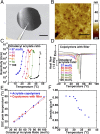Ultraflexible, large-area, physiological temperature sensors for multipoint measurements
- PMID: 26554008
- PMCID: PMC4664374
- DOI: 10.1073/pnas.1515650112
Ultraflexible, large-area, physiological temperature sensors for multipoint measurements
Abstract
We report a fabrication method for flexible and printable thermal sensors based on composites of semicrystalline acrylate polymers and graphite with a high sensitivity of 20 mK and a high-speed response time of less than 100 ms. These devices exhibit large resistance changes near body temperature under physiological conditions with high repeatability (1,800 times). Device performance is largely unaffected by bending to radii below 700 µm, which allows for conformal application to the surface of living tissue. The sensing temperature can be tuned between 25 °C and 50 °C, which covers all relevant physiological temperatures. Furthermore, we demonstrate flexible active-matrix thermal sensors which can resolve spatial temperature gradients over a large area. With this flexible ultrasensitive temperature sensor we succeeded in the in vivo measurement of cyclic temperatures changes of 0.1 °C in a rat lung during breathing, without interference from constant tissue motion. This result conclusively shows that the lung of a warm-blooded animal maintains surprising temperature stability despite the large difference between core temperature and inhaled air temperature.
Keywords: biomedical devices; flexible electronics; organic electronics; temperature sensor.
Conflict of interest statement
The authors declare no conflict of interest.
Figures




References
-
- Arora N, et al. Effectiveness of a noninvasive digital infrared thermal imaging system in the detection of breast cancer. Am J Surg. 2008;196(4):523–526. - PubMed
-
- Shevelev IA. Temperature topography of the brain cortex: Thermoencephaloscopy. Brain Topogr. 1992;5(2):77–85. - PubMed
-
- Bagavathiappan S, et al. 2009. Infrared thermal imaging for detection of peripheral vascular disorders. J Med Phys 34(1):43–47.
-
- Kim DH, et al. Epidermal electronics. Science. 2011;333(6044):838–843. - PubMed
Publication types
MeSH terms
Substances
LinkOut - more resources
Full Text Sources
Other Literature Sources

